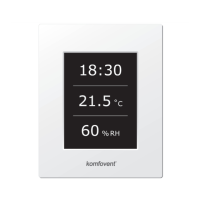EN
UAB KOMFOVENT we reserve the right to make changes without prior notice
C5.1_22- 08
14
2.5.4.1. Air handling unit settings
Temperature control
The air handling unit provides for several tem-
perature control modes:
• Supply. The unit supplies air according to the
temperature preset by the user.
• Extract. Unit automatically supplies air of such
temperature to maintain preset exhaust air
temperature.
• Room. Operation is similar to the mode “ex-
haust” but temperature is maintained by the
sensor mounted in the room (B8).
• Balance. Supply air temperature maintenance value will be determined automatically from the exist-
ing exhaust air temperature, i. e., what temperature air will be removed from the premises, the same
temperature air will be supplied back.
When “Balance” is selected, the temperature setpoint disappears.
Air volume control
Supply and exhaust air volumes control modes have been provided in the unit:
• CAV – constant air volume control mode. The unit will supply and extract a constant air ow which
is preset by the user, irrespective of any changes occurring in the ventilation system;
• VAV – variable air volume control mode. The unit will supply and extract an air ow with regard to
the ventilation needs in dierent rooms. In case of frequently changing ventilation demands this air
volumes maintenance mode signally reduces unit exploitation costs.
It is possible to use a simplied VAV control function, “single-ow VAV control”. It means that the
performance of this function requires only a single air ow pressure sensor, which is installed in
a variable air duct system (e.g. in supply air). This variable system is called the master ventilation
system, according to which control is performed, while the other air ow (in this case, discharged
air) operates as the slave ventilation system and always follows the master one. If the supply air re-
quirement in the ventilation system which is assigned as the master system decreases, the intensity
of discharged air in the slave system is reduced correspondingly by the same percentage.
If the variable air volume control function is mode is selected, the initial calibration
of the control mode must be performed; otherwise, the unit will not operate if the
VAV mode is selected.
Variable air volume control mode calibration:
1. Before start of calibration the air distribution and exhaust devices in ventilation system should be
adjusted, all valves for variable air ow in a way enabling air supply to all ventilated premises should
be opened.
2. After switch on of the unit the VAV mode should be selected and calibration procedure should be
conrmed. After the end of the calibration, depending on the conguration of pressure sensors, VAV
mode status will change to Supply, Extract, Double.
3. After calibration the air handling unit further will operate in the previous mode.
• DCV– direct controlled volume. The air handling unit will operate similarly as in the CAV mode, but
air volumes will be maintained directly in accordance with the values of the B6 and B7 analog input
signals of controller. After giving the signal 0... 10 V to the appropriate input, it will be converted
according to the current determined air volume. For example, if the maximum air ow of the unit is
1000 m
3
/h, setpoint in the panel – 800 m
3
/h, and the B6 input value – 7 V, the unit will supply constant
air volume of 560 m
3
/h, i.e., 70% of the set value. The same applies to the exhaust air only by B7 input.
Air handling unit
Temperature control
Flow control
Air quality
Time/Date
Connectivity
1 / 2
Reset settings
Air handling unit
Panel sensor calibration
2 / 2

